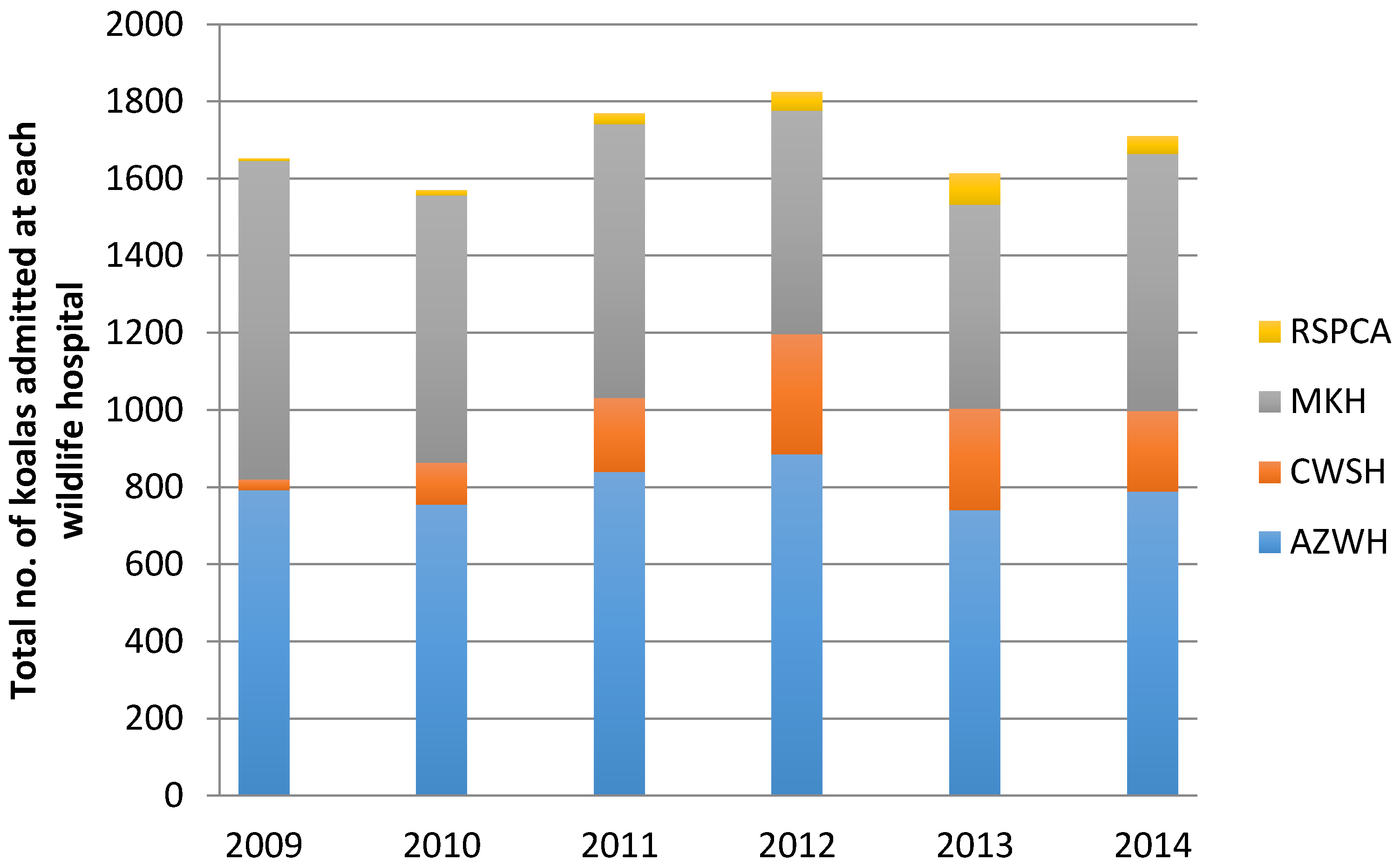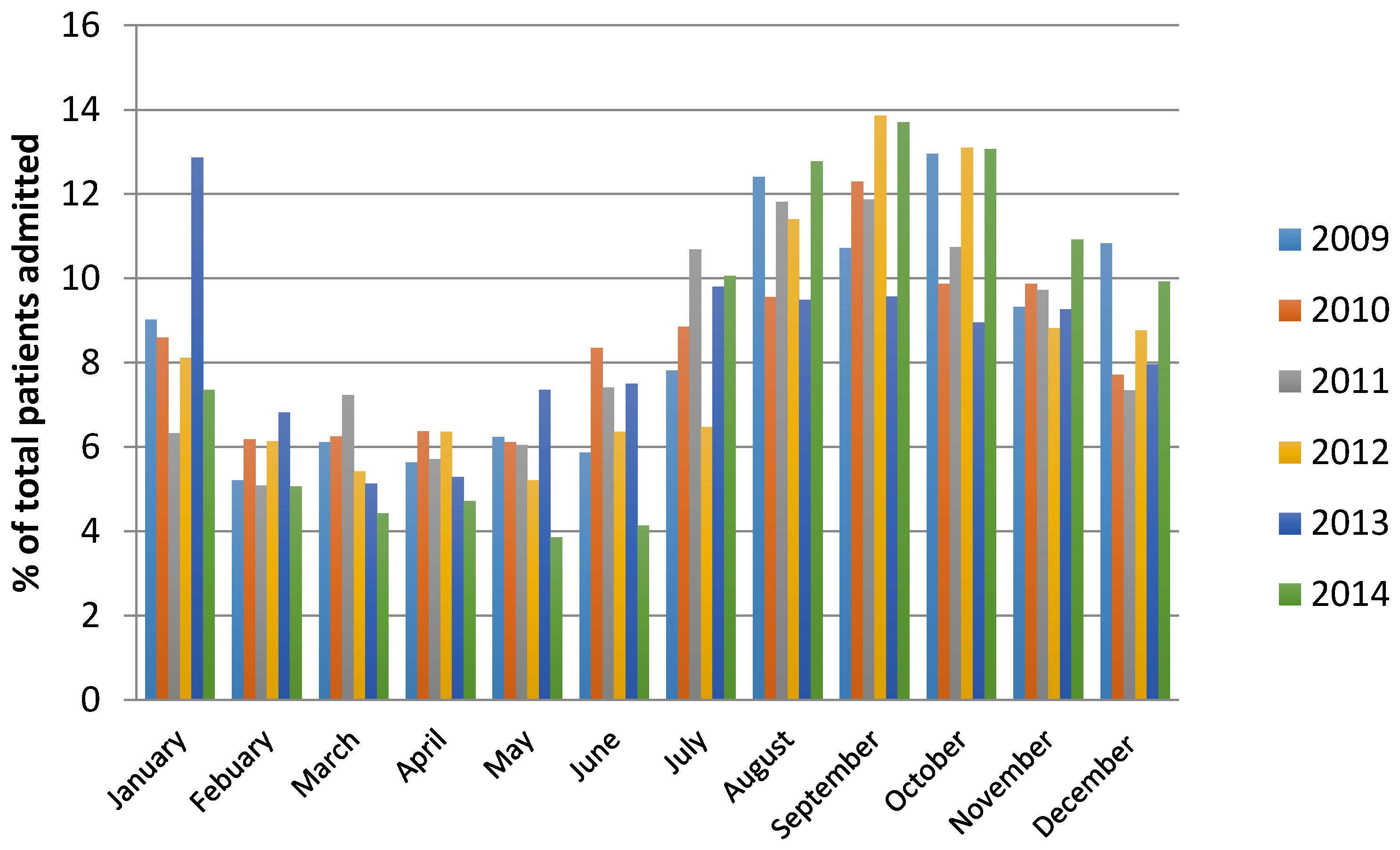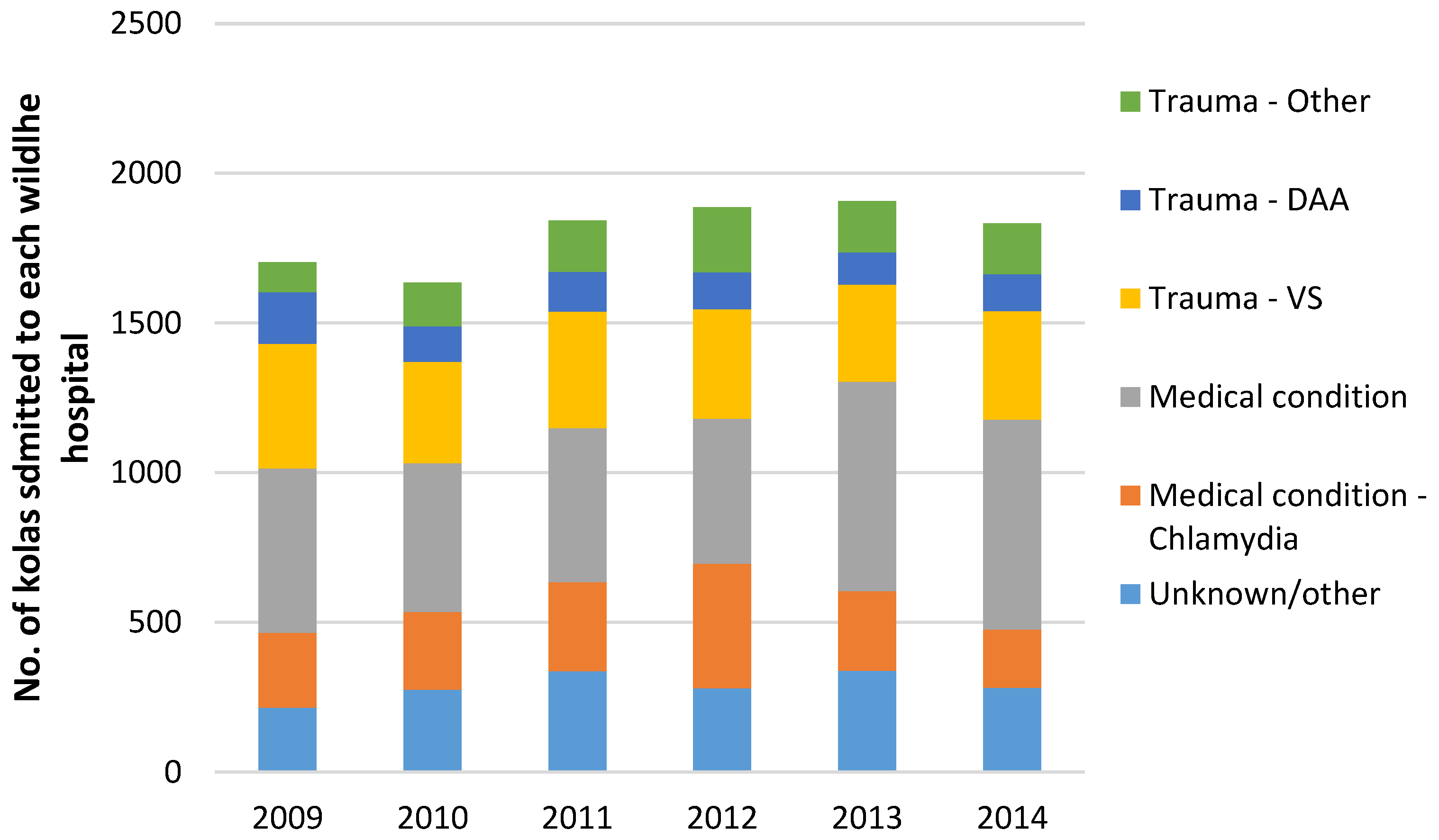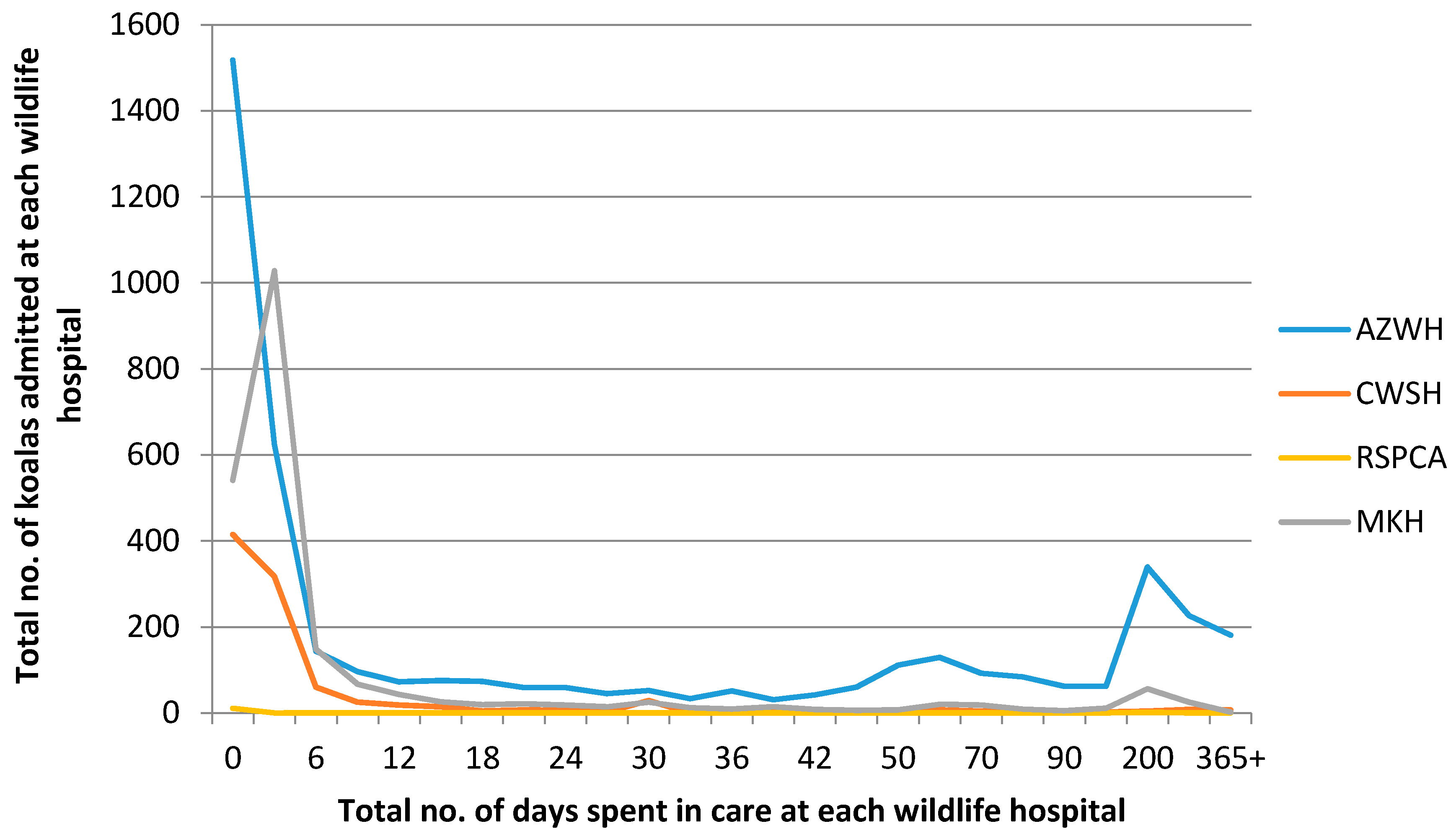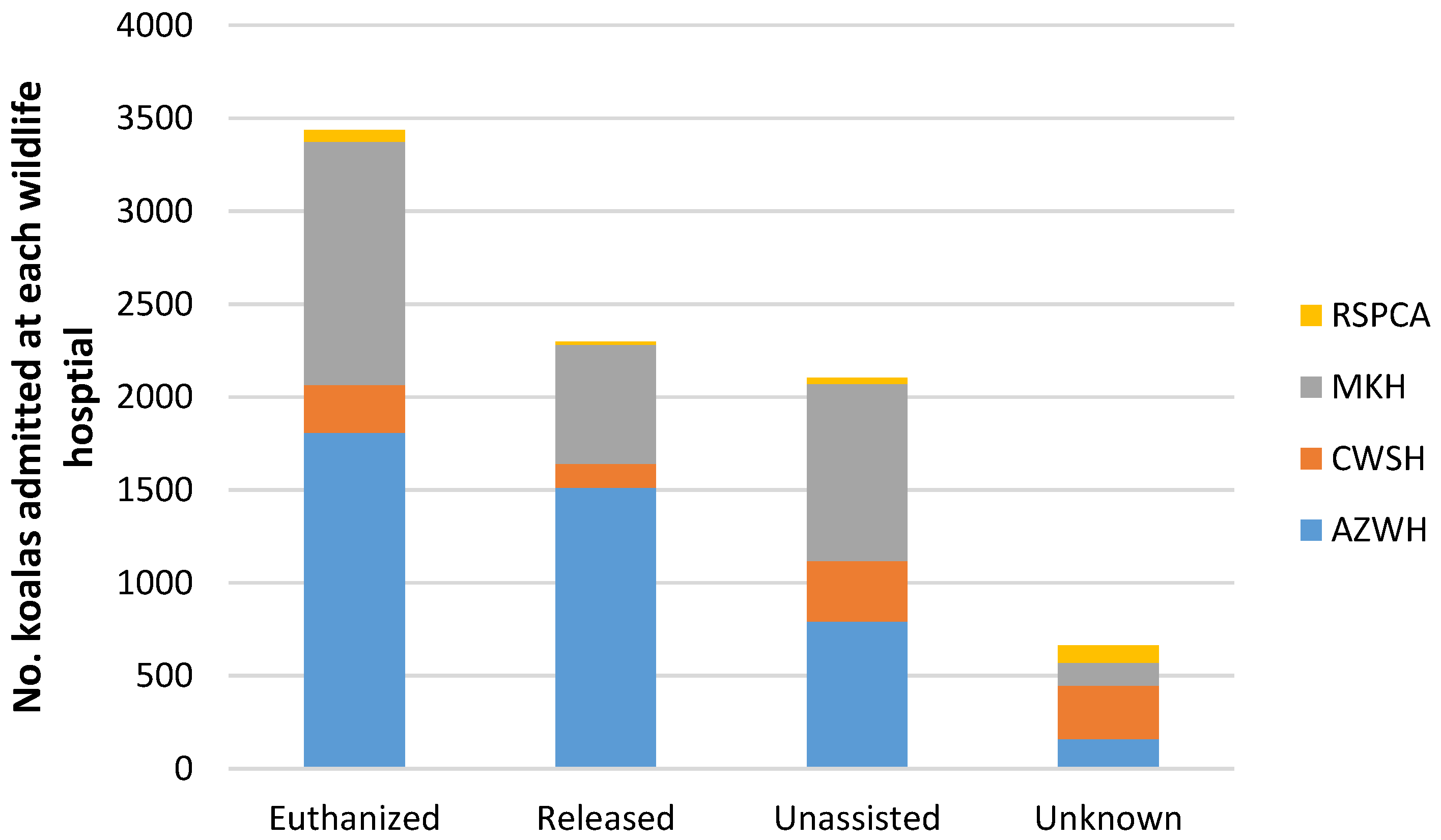4.1. Admission Rates of Koalas into Wildlife Hospitals
Approximately 10,000 koalas were admitted across the four wildlife hospitals throughout the six-year study period, with approximately 1600 admitted per annum. The largest intake of koalas was seen during 2012, where over 1800 animals were admitted (see
Figure 1).
The AZWH admitted the most koalas in the study period with 4804 animals. This was followed by the MKH with 4004 koalas, CWSH with 1107, and the RSPCA 224. It was expected that AZWH and the MKH would have the largest intake of koalas due to their specialist care of the species and the facilities available for treating and holding koalas over longer periods.
Intake variation may also be attributed to other factors including operation hours, which vary between establishments (AZWH and RSPCA are open 24/7 whilst the MKH and CWSH have differing opening hours throughout the week). Admissions to AZWH, CWSH and the RSPCA all remained relatively constant during the study period, while the MKH koala admissions slightly decreased over time (see
Figure 1). This decline may be attributed to a number of factors including a decline in koalas within the areas of southeast Queensland that are most frequently served by MKH, or that more koalas were taken to the other hospitals for unknown reasons.
The results also show that the number of koalas being admitted each year remained stable over the six-years. However, evidence suggests that the overall koala population in southeast Queensland has decreased significantly. In 2013 Wildlife Queensland conducted a survey of koala numbers throughout the Koala Coast region of southeast Queensland and found that it had decreased considerably in recent years. The population was estimated to be 6246 throughout the region during 1999, but was found to have dropped to 2279 by 2008, a 64% decline over ten years [
9].
Therefore, it can be inferred that whilst koala populations seem to be in decline across the region, koala admission rates remain steady or increasing due to factors including continued urbanization and the threats associated with the growing human population within the area. Ultimately, we can presume these pressures to be having a relative impact upon koala populations and their ability to cope with rising challenges including domestic dog attacks and vehicle collisions. At the same time, it may be that people are becoming increasingly aware of koalas living in their local communities and actively rescuing sick, injured and orphaned individuals. Of course if the total population of free-living koalas in southeast Queensland continues to decline, this will eventually reduce the numbers being admitted to wildlife hospitals.
The admissions data also demonstrate a seasonal effect with more koalas being admitted during the spring and early summer months (
Figure 2). This is consistent with the koala breeding season, when more individuals are dispersing to find mates, and in the process are more prone to becoming victims of vehicle or domestic animal attack.
4.2. Causes of Admission
Rural and urban koala populations in southeast Queensland have decreased, fundamentally influenced by human-related activities including domestic dog attacks and vehicle collisions, along with other naturally occurring factors including bushfires [
10]. This finding was somewhat supported by the evidence from this study. Direct and indirect human impacts were a primary influence on admissions rates through vehicle collisions and domestic animal attacks, however the results from this study also found medical conditions, particularly chlamydiosis to be the major cause of admission (see
Figure 3).
The results indicate that more than half of the koalas were admitted for a “medical condition”, of which 196 had been diagnosed as “chlamydiosis” (12%). However, 40% of the other “medical condition” admissions comprised undiagnosed conditions, and many of these may have involved chlamydiosis but cannot be confirmed due to the lack of detailed medical records for these cases.
This is supported by the prevalence of the disease from other research projects conducted throughout southeast Queensland, with infection rates of chlamydiosis in koalas ranging from 43 to 57% within wild populations in southeast Queensland [
11].
A further 38% had suffered from “trauma”, of which more than half were caused by vehicle strikes and about 20% from attacks by domestic animals.
Most causes of admission, including vehicle strikes appeared to remain relatively consistent throughout the study period, with some instances including domestic animal attacks even decreasing over time. However, chlamydiosis appeared to increase in prevalence from 2009 to 2012 followed by a steady decline from 2013 to 2014 (see
Figure 3).
It is reasonable to suggest that disease associated with rapid urbanization in southeast Queensland is increasing affecting wild koala populations, and this may be of concern for the future viability of the species in this region. This is supported by the finding that 20% of all koala admissions to the Port Macquarie Wildlife Hospital in New South Wales were due to clinical signs of chlamydiosis (conjunctivitis and cystitis), second to admissions caused by trauma [
12]. According to Dique et al. [
13], unless there is proper planning to mitigate further habitat fragmentation, it is likely that the local population of koalas will continue to be threatened by chlamydiosis (which is believed to be exacerbated by stress), vehicle strikes and domestic dog attacks.
However, it is also apparent that in many cases the data did not allow for a definitive diagnosis or identification of the precise cause of admission. These inconsistencies in the dataset demonstrate poor record keeping, likely to reduce the accuracy of research into koala rehabilitation in wildlife hospitals.
The development of better admittance record keeping systems (particularly databases) and protocol is one of the most influential areas that would facilitate both higher quality and broader scope research to develop better management practices. An example format could be a universal database accessible from an online webpage (stored using cloud technology). The use of drop-down menus is highly recommended (rather than typed entry) to facilitate analysis and report functions although the option to add notes, especially if a value of other or unknown were selected would also be useful. Context sensitive language and features would help increase usability. It is also recommended that multiple entry fields be utilized for cause of arrival/history to better account for causation.
4.3. Time Spent in Care
Figure 4 shows that most koalas were in core care less than one week across the four wildlife hospitals. This is consistent with the average length of stay of wildlife patients across Victorian shelters, with less than 5 days for 6% of admissions, followed by 29% after 10 days, 21% after 25 days and only 7% were still in care after 100 days [
14].
However, AZWH also showed a significantly prolonged time in care for some animals, with 17% of koala patients still in care after two hundred days, and some for longer than a year. This finding is consistent with a recent news article claiming AZWH spent two years to successfully rehabilitate a single koala that had contracted chlamydiosis [
14]. AZWH maintained the prolonged treatment of the animal provided invaluable research opportunities into chlamydiosis, and how to improve treatment regimens for future patients [
15].
However, other researchers suggest prolonged rehabilitation can jeopardise survival following release therefore the process should be as short as possible, and some animals should be euthanized on first examination rather than being allowed to die in captivity at a later time [
14].
4.4. Outcomes of Rehabilitation
Most (66.5%) rescued koalas were either euthanized or died in care with only 27% returned to the wild.
Similar studies of wildlife rehabilitation in both Australia and the United States show that more than 40% of animals could be released to the wild [
14] compared with the 27% found in this study for koalas. Studies conducted on similar marsupial species describe a range of both optimistic and pessimistic outcomes, some results found no difference in release methods of hand-reared eastern grey kangaroos and the overall outcome of rehabilitation efforts a relative success [
16], whilst others found that almost all hand-reared ringtail possums to be taken by predators soon after release [
17].
As the wild koala population in southeast Queensland continues to decline, the fact that only one in four koalas admitted across the major wildlife hospitals are successfully rehabilitated and suitable for release is likely to be of increasing concern in the future. Similarly, due to the current lack of objective information regarding post-release survival rates, it remains unclear as to what effect current rescue and rehabilitation techniques are having upon southeast Queensland koala populations.
The relatively small proportion of successfully released koalas throughout the study period may be simply due to the severity of admission causes or the difficulty in treating and successfully rehabilitating koalas. Nonetheless, it does highlight the need for further research and resources to improve current treatment and rehabilitation regimens.
The results also show that the rates of release and euthanasia found amongst the four wildlife hospitals varied: AZWH released 35% and euthanized 42%, MKH released 21% and euthanized 43%, CWSH released 13% of its admitted koalas and euthanized 26% and the RSPCA released 7% of admitted koalas and euthanized 31% (see
Figure 5). Such variations may suggest that there are differences in the treatment regimens employed by each hospital. This finding is consistent with similar research that found case outcomes for koalas admitted with chlamydiosis differed across wildlife hospitals [
12].
Outcome decisions at koala hospitals are largely based on clinical signs rather than including diagnostic tests [
12]. This can be problematic because underlying health issues can go unidentified or untreated, also this may encourage only the treatment of clinical signs and ignore core, complex diagnosis and subsequently void all treatment efforts. Case outcomes based on clinical signs alone are likely to cause problems for the health of individual animals and the population, reducing fertility and long term survival of koala populations [
12]. By ignoring subclinical signs of chlamydiosis, koala hospitals are likely overlooking valuable opportunities to decrease infection rates and the relative effects of disease in local koala populations [
12].
Similarly, findings from investigated case outcomes at three major wildlife hospitals in the southeast Queensland and northern New South Wales concluded that different standards and procedures were commonly employed [
18]. In addition, the three facilities also seemed to base their treatments almost entirely on the presence of clinical signs of disease, rather than on diagnostic testing to determine other underlying factors that may be affecting the animal [
18].
Other evidence suggests wildlife hospitals differ in how they manage and treat koalas, highlighted by a recent disagreement between koala rescue groups in southeast Queensland. Moreton Bay Koala Rescue (MBKR) admits all their rescued koalas to the AZWH [
19], but Pine Rivers Koala Care (PRKC) prefers the government-run MKH. Rescuers from the MBKR believe that the AZWH has a higher survival rate but rescuers from PRKC dispute this with comparable survival rates from the MKH [
19].
Other evidence to suggest differences in attitudes and protocol in regards to case outcomes is highlighted in a news article by Fraser [
19] that suggests AZWH on average spends up to $5000 on medical treatment for each koala admitted into their facilities. Similarly, one koala recently admitted into the AZWH spent two years in care due to ongoing effects of chlamydiosis, with treatment costs of the animal reaching $20,000 [
19].
Consequently, some researchers conclude that rehabilitation and treatment procedures for koalas need to be specifically addressed to minimize wastage, maintain high animal welfare standards and ensure its effectiveness for both the rehabilitated individual and the local resident population to which they will return [
12]. They maintain that despite their financial and regulatory restraints, wildlife hospitals should be reevaluating their rehabilitation and treatment protocols to develop consistent and effective treatment regimens of each koala and population.
